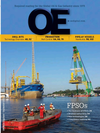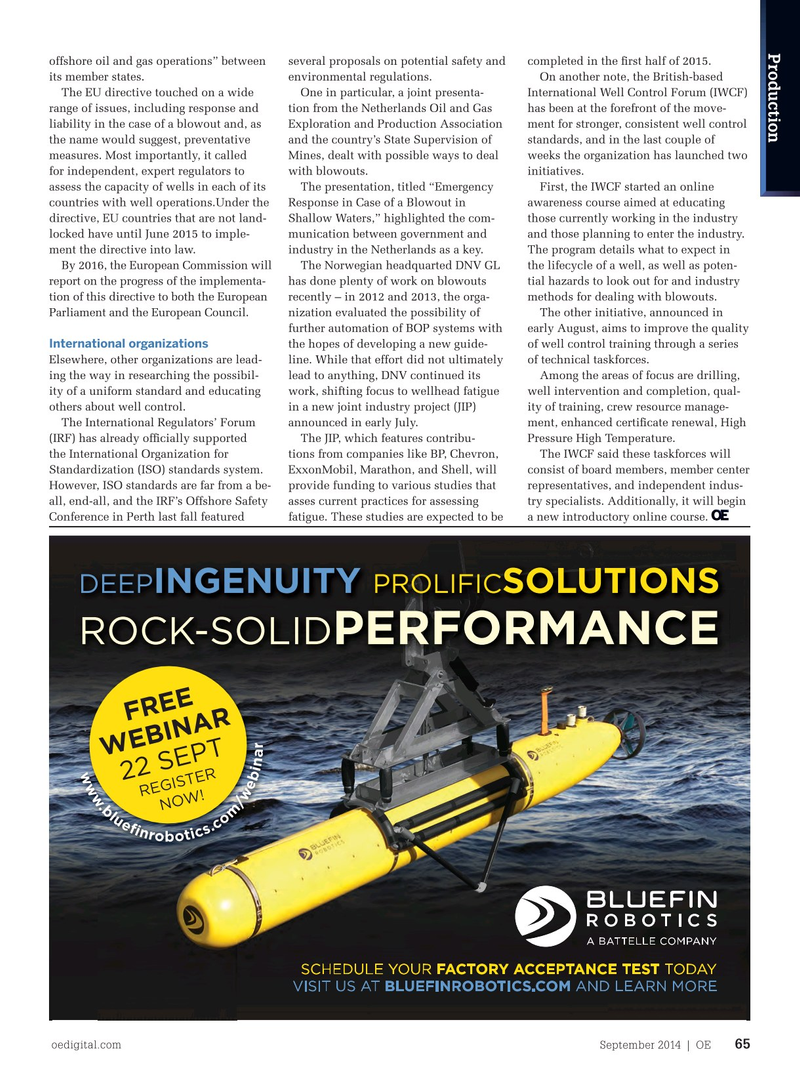
Page 63: of Offshore Engineer Magazine (Sep/Oct 2014)
Read this page in Pdf, Flash or Html5 edition of Sep/Oct 2014 Offshore Engineer Magazine
EyebrowProduction offshore oil and gas operations” between several proposals on potential safety and completed in the ? rst half of 2015. its member states. environmental regulations. On another note, the British-based
The EU directive touched on a wide One in particular, a joint presenta- International Well Control Forum (IWCF) range of issues, including response and tion from the Netherlands Oil and Gas has been at the forefront of the move- liability in the case of a blowout and, as Exploration and Production Association ment for stronger, consistent well control the name would suggest, preventative and the country’s State Supervision of standards, and in the last couple of measures. Most importantly, it called Mines, dealt with possible ways to deal weeks the organization has launched two for independent, expert regulators to with blowouts. initiatives. assess the capacity of wells in each of its The presentation, titled “Emergency First, the IWCF started an online countries with well operations.Under the Response in Case of a Blowout in awareness course aimed at educating in the loss of well control and the explo- directive, EU countries that are not land- Shallow Waters,” highlighted the com- those currently working in the industry sion. Therefore, as BSEE undertook this locked have until June 2015 to imple- munication between government and and those planning to enter the industry. rulemaking, we diligently worked to ment the directive into law. industry in the Netherlands as a key. The program details what to expect in ensure it would address well control in By 2016, the European Commission will The Norwegian headquarted DNV GL the lifecycle of a well, as well as poten- a more comprehensive way.” report on the progress of the implementa- has done plenty of work on blowouts tial hazards to look out for and industry tion of this directive to both the European recently – in 2012 and 2013, the orga- methods for dealing with blowouts.
Europe
Parliament and the European Council. nization evaluated the possibility of The other initiative, announced in
In March 2009, a year before Macondo, further automation of BOP systems with early August, aims to improve the quality
International organizations the International Association of Oil and the hopes of developing a new guide- of well control training through a series
Gas Producers (OGP) held a drilling stan- Elsewhere, other organizations are lead- line. While that effort did not ultimately of technical taskforces. dards workshop. ing the way in researching the possibil- lead to anything, DNV continued its Among the areas of focus are drilling,
The organization ity of a uniform standard and educating work, shifting focus to wellhead fatigue well intervention and completion, qual- recognized a few others about well control. in a new joint industry project (JIP) ity of training, crew resource manage- major concerns within The International Regulators’ Forum announced in early July. ment, enhanced certi? cate renewal, High the industry with (IRF) has already of? cially supported The JIP, which features contribu- Pressure High Temperature. regards to well control the International Organization for tions from companies like BP, Chevron, The IWCF said these taskforces will equipment – namely, Standardization (ISO) standards system. ExxonMobil, Marathon, and Shell, will consist of board members, member center that there were very However, ISO standards are far from a be- provide funding to various studies that representatives, and independent indus-
Deep Ingenuity - 1-2 Ad 184x130 (Outlines) Sept.pdf 1 8/13/14 11:17 AM few internationally all, end-all, and the IRF’s Offshore Safety asses current practices for assessing try specialists. Additionally, it will begin recognized standards Conference in Perth last fall featured fatigue. These studies are expected to be a new introductory online course. to follow.
In a presentation from that workshop,
OGP acknowledged four API standards – RP 53, RP 59, RP 64, and RP 16Q as “the only practical documents available to … install, test, and use well control
C equipment.”
That presentation
M cited the need for a set
Y of international standards because of the
CM increasing number of drilling contractors from Europe and Asia that do not follow
MY
API standards.
CY
Five years later, there is still no set of
CMY internationally recognized standards on well control, but there are a host of orga-
K nizations around the world working to increase awareness of proper well control procedures in the wake of Macondo.
Last year, the European Union announced its Directive on the Safety of Offshore Oil and Gas Operations as a direct response to Deepwater Horizon and other incidents. The directive sought to address what it called “the existing divergent and fragmented regulatory framework applying to the safety of oedigital.com September 2014 | OE 65 064_OE0914_ProdOps1_overview.indd 65 8/21/14 5:21 PM

 62
62

 64
64